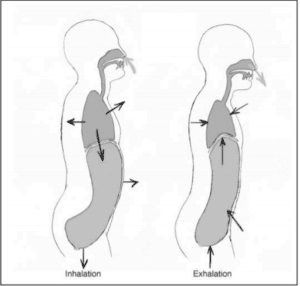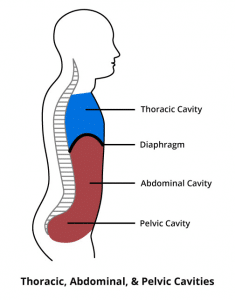Introduction to Pranayama
‘From the first faint breath of the infant to the last gasp of the dying man, it is one long story of continued breathing. Life is but a series of breaths’ says Yogi Ramacharaka in the early 1900s book ‘The Hindu-Yogi Science of Breath’. We begin life on an inhale and die on an exhale. Pranayama teaches us to breathe in a way that will keep us healthier and more prepared for whatever challenge we are facing
Within the Sanskrit word, ‘Pranayama’, is the word ‘Prana’, which when capitalised refers to the manifestation of all creative life force. In Chinese medicine this is known as ‘Qi’, in yoga, we called this Prana. The second half of the word, ‘yama’, means ‘control’ in Sanskrit. The practice of Pranayama is the practice of controlling the life force that is entering and leaving our bodies.
Abdominal Breathing / Belly Breathing / Low Breathing
If you have attended any of my classes, you will have been asked by me to try to breathe into your belly. In our stressful modern lives, many of us will have developed the habit of breathing using only the very top parts of our lungs. In the Chapter 7 of the aforementioned book, Yogi Ramacharaka states, ‘High breathing is probably the worst form of breathing known to man…’ ‘The upper part of the chest and lungs, which is the smallest, is used…a maximum amount of effort is used to obtain a minimum amount of benefit’. You might have noticed if you are anxious, you find it hard to complete a deep breath, this is because you are not using your whole lung capacity, and it is likely that you are breathing only into the top of your lungs. This makes us more anxious, more alert and more stressed.
How to
The best way to begin practising your belly breathing is to lie flat on the floor (keep your knees bent and place soles of the feet on the floor if your back is sore). Place your hands on your tummy, and begin breathing into your hands; see if you can make your hands rise and fall as your breath moves your belly up and down.
What is happening here?
 Fig 1.
Fig 1. Fig 2.
Fig 2.
The diaphragm, as labelled in Figure 2, is a single muscle which sits in a dome shape under the lungs and above the organs of the abdominal cavity (labelled in Figure 1). Figure 2 indicates that when we inhale, the diaphragm should push down into the abdominal cavity, meaning that the belly rises. With the exhale, the diaphragm lifts back up into the thoracic cavity (Figure 1), causing the belly to fall again. This is what is meant by ‘belly breathing’, ‘abdominal breathing’ or ‘diaphragmatic breathing’.
3 Parts Breath or Yogi Complete Breath
Having had some practice in belly breathing, the next Pranayama technique to practice is the 3 Parts Breath or Yogi Complete Breath. This takes some practice and can be challenging as we start to try to activate respiratory muscles that we might not have used in a while! The most important thing is to become aware of these techniques, and to gently start incorporating them into your life. ‘It brings into play the entire respiratory apparatus, every part of the lungs, every air-cell, every respiratory muscle.’ (The Hindu-Yogi Science of Breath, Yogi Ramacharaka, Chapter 7).
How to
To start, let’s think of our torso in three parts; the belly, the ribs and the upper chest. Practice this technique lying down to start with to make it easier. When we do three-parts breath, we fill first the belly, then the ribs, then the upper chest with air. When we exhale, we empty the chest, then the ribs then the belly. Think of this as filling yourself with air from the bottom up, then emptying the air from the top down. If you are finding it hard to breathe into a particular area, try placing your hands on that area. This helps us to direct our breath to that area
Yogi Cleansing Breath
After practicing some breath techniques, finish off by taking some cleansing breaths. Let’s take our instruction from Chapter 10 of the Hindu-Yogi Science of Breath:
‘Inhale a Complete Breath’ (through your nose)
‘Retain air a few seconds.’
‘Pucker up the lips as if for a whistle (but do not swell out the cheeks), then exhale a little air through the opening, with considerable vigour. Then stop for a moment retaining the air, and then exhale a little more air. Repeat until the air is completely exhaled…’
This is a good way to finish off any breath or yoga practice. I would also recommend this as a way of calming the nerves and to ground yourself before taking on something challenging, be that performing on stage or psyching yourself up before a meeting.
There are many more Pranayama techniques to explore but I would suggest these three as a perfect place to start. They are some of the foundational techniques, and by bringing these into your yoga practice and daily life, I hope you find some clarity, peace and calm! I would recommend the glossary below for further readings, next blog post will include some further Pranayama techniques! Happy breathing. Namaste.
References
Thank you to the following books and articles:
https://teamsunwellness.com/2017/10/14/breath/
https://www.yogaanatomy.org/wp-content/uploads/2011/10/Anatomy-of-Breath2.pdf
Yoga Anatomy 2nd Edition, Leslie Kaminoff and Amy Matthews, 2012
The Hindu-Yogi Science of Breath, Yogi Ramacharaka, 1901
The Power of Breath and Hand Yoga, Pranayama and Mudras for Health and Wellbeing, Christine Burke